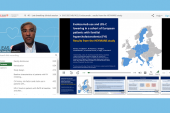Stepwise or Hammer Down? Experts Debate Best Approach to LDL-Lowering
Most agree that for high-risk patients a combination approach is necessary to avoid clinical inertia and to drive down LDL fast.

MILAN, Italy—When it comes to aggressive LDL-lowering, physicians have the option of pulling out all the stops to slash cholesterol levels as quickly as possible or taking a slower, stepwise strategy.
Which approach might be best was debated by experts at a session devoted to the current lipid guidelines at the 2022 European Atherosclerosis Society (EAS) Congress.
Taking the position that physicians should come out hard and heavy, Lluís Masana, MD (Hospital Universitari Sant Joan/Universitat Rovira i Virgili, Reus, Spain), said the problem with the step-by-step approach is that clinical inertia sets in, leaving patients with LDL-cholesterol levels that are still too high.
“Maybe I’m now convincing some of you that you have to probably change your clinical practice,” he said. “[You’re thinking,] ‘Next week, I’m going to call those patients up and I will add some new lipid-lowering drugs to their statins. In all patients, after starting with a statin, I will consider [other lipid-lowering agents] on the second visit.’” But Masana’s prediction? “You’re not going to do it. You have to do it from the outset otherwise you will never obtain the optimal benefit of these therapies.”
Backing up that claim, Masana cited data from the ACS Patient Pathway Project showing that 78% of patients did not have their LDL-cholesterol levels at goal at their first follow-up visit. For those not at goal, only 59% had their treatment changed. At the second visit, 68% of patients were still not at goal but only 39% had their treatment adjusted. Finally, by the third visit, 62% still had LDL levels too high but only one-third of these patients had their treatment altered. A large percentage of patients not at goal didn’t even have follow-up visits, noted Masana.
Two Patients, Two Treatments
François Mach, MD (Geneva University Hospital, Switzerland), who co-chaired the European Society of Cardiology (ESC)/EAS dyslipidemia guidelines, took the other side of argument, stating that a stepwise approach to treatment—slow and sure—is best. Importantly, he argued, the approach needs to be personalized because that strategy encourages patient involvement and shared decision-making.
“We are all different individuals,” he said. “That’s why I strongly believe that we should have for each of our patients a different approach.”
The ESC/EAS dyslipidemia guidelines recommend physicians start first with an assessment of atherosclerotic cardiovascular disease (ASCVD) risk and then treat based on that risk. In very-high-risk patients, they push for at least a 50% reduction in LDL cholesterol from baseline and a target of less than 1.4 mmol/L (< 55 mg/dL). For high-risk patients, the goal is also a 50% reduction in LDL cholesterol and a target of less than 1.8 mmol/L (< 70 mg/dL). For low- and moderate-risk patients, the targets are less than 2.6 and 3.0 mmol/L (< 100 and < 115 mg/dL), respectively.
After patients are classified based on their ASCVD risk, the guidelines recommend a stepwise treatment intensification approach.
Speaking with TCTMD, Mach offered a personal anecdote to explain the need for personalization. His 90-year-old father currently has an LDL-cholesterol level of 2.0 mmol/L, he said. Based on the risk assessment, he’s technically not at goal. While Mach isn’t his father’s physician, he believes his father is managed optimally because reducing his LDL-cholesterol level down below 1.4 mmol/L wouldn’t be worth the small gains in ASCVD-free life-years.
On the other hand, he continued, he wouldn’t take the same approach for a 55-year-old patient with recent ACS.
“You have to spend time, and even more money, for the young patient than for my father,” Mach said. In the younger patient, Mach is also more inclined to be aggressive from the start. “If she has LDL-cholesterol levels above 3 or 4 mmol/L, then start with combination therapy to obtain as soon as possible the lowest LDL-cholesterol level possible,” he advised.
Mach said that advances in LDL-lowering should allow physicians to meet the specific targets outlined in the guidelines, even the very low cholesterol goals for very-high-risk patients, provided the drugs are covered by insurance or are commercially available. Still, the topic of patients “at goal” can be an emotional one, conceded Mach. While there are data suggesting that just one-third of patients are at goal, those don’t capture the individuals’ risk factors and some of the difficulties they might encounter with treatment.
“We’re trying to push doctors to think more about LDL cholesterol, and I’m a strong believer that lower LDL means lower risk,” said Mach. For some patients, though, even if the LDL remains above the recommended target, there might be legitimate clinical reasons for it being so, said Mach.
You Just Can’t Get Down That Low
Kausik Ray, MBChB, MD (Imperial College London, England), president of EAS, said statins are cheap and widely available, with a lot of data supporting their use. However, he also pointed that the European guidelines changed from 2016 to 2019, with a new lower target for those at the highest risk. With this new target, it is “mathematically impossible” for some patients (depending on their baseline LDL levels) to lower their LDL to less than 55 mg/dL with a single drug.
“You just can’t do it,” said Ray. “You’ve changed the goalposts and as a result you need to reassess [treatment].”
In the DA VINCI registry, for example, 30% of patients with ASCVD achieved the cholesterol targets set out in the 2016 guidelines, but only 18% of patients were at goal according to the stricter 2019 targets. If patients were treated with a PCSK9 inhibitor plus another agent, however, more than half achieved the targets in the 2019 guidelines. Data from the HEYMANS registry in patients treated with evolocumab showed a similar result. In that study, use of the PCSK9 inhibitor brought 71% of patients to a target of less than 1.8 mmol/L and 58% to less than 1.4 mmol/L. If a statin and/or ezetimibe was used with evolocumab, 80% and 67% met the treatment targets of 1.8 and 1.4 mmol/L, respectively.
“We often get questions, ‘Can I use this new drug and drop the old one?’” said Ray. “If you’re aiming for a low LDL goal, the answer is no. It’s combination therapy.”
Masana agreed, highlighting an array of options for practicing physicians. If bigger reductions in LDL cholesterol are needed, say in the range of 60% to 80%, then combination therapy is an absolute must, he said. Treatment combinations would include oral medications as well as the PCSK9 inhibitors alirocumab (Praluent; Sanofi/Regeneron) and evolocumab (Repatha; Amgen) and small-interfering RNA inclisiran (Leqvio; Novartis). There are data from SWEDEHEART, he noted, showing the CVD benefits of reducing LDL-cholesterol levels as quickly as possible compared with more slowly.
Both Masana and Ray argued for a paradigm shift in terms of treating of patients. Instead of thinking about high-intensity statin treatment, it’s now time to consider high-intensity “lipid-lowering” therapy, said Masana. Ray made a similar push, stating that physicians should start thinking of “combination therapy” instead of high-intensity statins in selected patients.
The reason for the aggressive approach, said Masana, is that LDL-lowering is the only therapy addressing the etiology of arteriosclerosis. Several recent studies, for example have demonstrated that intense LDL-cholesterol-lowering with PCSK9 inhibitors—PACMAN-AMI with alirocumab and HUYGENS with evolocumab—reduced atheroma volume and lipid core of atherosclerotic plaques as well as increased fibrous cap thickness. Other imaging studies have previously demonstrated that statin therapy can also transform coronary lesions into more-stable plaque.
In the high- and very-high-risk patients, it’s not just about preventing future CVD events, but also about treating the disease of atherosclerosis, said Masana.
Mach told TCTMD the ESC guidelines for cardiovascular disease prevention do make room for physicians to use combination therapy as the first-line strategy in high-risk and very-high-risk patients. In high-risk patients, starting with a statin and ezetimibe is recommended, while a statin, ezetimibe, and PCSK9 inhibitor are recommended in the highest-risk patients, such as post-ACS patients with a history of other vascular events, PAD, multivessel CAD, or familial hypercholesterolemia.
Michael O’Riordan is the Managing Editor for TCTMD. He completed his undergraduate degrees at Queen’s University in Kingston, ON, and…
Read Full BioSources
Ray KK. What’s been achieved and what more is needed—real-world evidence. Presented at: EAS Congress 2022. May 22, 2022. Milan, Italy.
Masana L. Start with combination therapy and get on with it. Presented at: EAS Congress 2022. May 22, 2022. Milan, Italy.
Mach F. Slow and sure wins the race—a stepwise approach. Presented at: EAS Congress 2022. May 22, 2022. Milan, Italy.
Disclosures
- Mach reports no relevant conflicts of interest.
- Ray report research funding from Amgen, Daiichi-Sankyo, Regeneron, and Amgen. He reports consulting to and/or serving on an advisory board for Amgen, Sanofi, Regeneron, AstraZeneca, Lilly, Kowa, Viatris, NovoNordisk, Boehringer Ingelheim, Esperion, Abbott, CRISPR, SCIBE, CARGENE, Novartis, Silence Therapeutics, New Amsterdam, and Bayer.





Comments